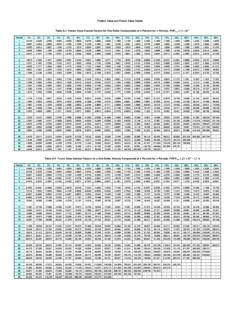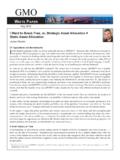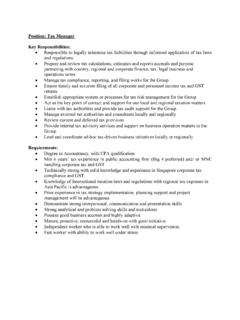Transcription of Determinants of Portfolio Performance— 20 Years …
1 FINANCIAL ANALYSTS JOURNAL-Letter fromL. Randolph Hood, CFAD eterminants of Portfolio performance 20 Years LaterWe would nothave guessed thata six-page articlewould be the focalpoint of a 20-yeardiscussion."It might be one of the most quoted numbers in applied finance: Ironically, it is also often misquoted or taken out of where did this number come from, and what does it reallyimply for Portfolio management? Also, importantly, what does itnot imply?In the early 1980s, Gary Brinson and I were wondering why ourinstitutional pension clients spent so much time and effort in man-ager searches and so little time in reviewing their asset allocationpolicies.
2 It was not as if all our clients had identical risk tolerances,liability streams, and funding policies. In discussions with theclients, we discovered that they had a firm belief that managerselection was important (and it is) because they could quantify thebenefits of superior management. They could not, however, orperhaps did not wish to, quantify the contributory effects of theirallocation policies on the returns to their funds. Explicit policies canbe embarrassing because they facilitate measurement of the successor failure of liability funding and the implementation of investmentprograms.
3 That is, poor outcomes resulting from asset allocationpolicies are difficult to blame on investment Randolph Hood, CFA, is the investment manager responsible for domesticemployee retiremen t plans at Prudential Financial, Inc., Newark, New 's Note: The article being discussed is " Determinants of PortfolioPerformance" by Gary P, Brinson, L, Randolph Hood, and Gilbert L,Beebower. First published in the July/August 1986 Financial AnalystsJournal, this article was republished in the 50th Anniversary Issue (January/February 1995) and is available online at It is the most visited FAJ article Milestones (1985-1994)
4 1986 Gary Brinson, RandolphHood, and GilbertBeebower find thatinvestment policyexplains 93,6 percent ofthe variation in totalplan Leibowitz arguesfor balancing the dura-tion of a fixed-incomeportfolio against theduration of the stream ofliabilities it is Perold andWilliam Sharpe discussestablishing a system ofexplicit rules for rebal-ancing in response tochanges in asset Roll analyzes theworldwide market crashof October 2005, CFA InstituteFINANCIAL ANALYSTS JOURNAL"Our clients considered liability valuation theprovince of actuaries, and liabilities were far toocomplicated and esoteric to analyze or to use inmaking policy decisions.
5 Nevertheless, we firmlybelieved that investment policy was the heart of theinvestment planning process. (And somewhatafter the fact, the funding debacle of 2001-2003illustrates allocation's importance. Over thatperiod, plan sponsors lost billions of dollars fortheir shareholders despite tremendous effortsdevoted to manager selection. The culprit wasasset allocation policies that were developed with-out adequate consideration of the range of possibleoutcomes or the behavior of the liabilities.)
6 So,convinced as we were in the 1980s of the impor-tance of allocation policy, and with the assistanceof Gilbert Beebower at SEI Corporation, who hadthe relevant data, we set out to explore the effectsof asset allocation policy on plan main finding was that, on average, of the variation of actual quarterly totalreturns from 1974 to 1983 of a sample of 91 largecorporate pension plans could be explained byusing proxy return series. The proxy series werecalculated by using each plan's average weightover the 40 quarters for equities, bonds, and cashequivalents and by applying passive index returnsfor those asset classes for each quarter.
7 Simply put,we found that the broad types of asset classes afund includes in a Portfolio and the proportionsthey represent have a profound effect on the vari-ability of returns. These decisions also directlyaffect the returns themselves, of course, althoughwe did not choose to stress that aspect. We con-cluded that asset allocation policy is an importantcomponent of the management process anddeserves careful consideration. We wanted plansponsors to iocus first on their liabilities and explic-itly consider what they were trying to achieve withtheir plans.
8 And with our research, we thought thepoint had been debates about the article's findings weresurprisingly numerous. Criticisms as well asdefenses of the approach and perceptions of thelessons to be learned from the article haveabounded. So, on behalf of my co-authors andmyself, I would like to address some of the mostprevalent observations and reactions that havebeen discussed in the last 20 want to start with one that we believe has notbeen discussed much at all: Nothing in the originalpaper suggests that active asset management isnot an important activity.
9 It was not the point ofour paper, and our goal was not to by our calculations it is true that theaverage plan over the time period we studied lostmoney from security selection and from markettiming as we defined the terms, some plans didquite well. In security selection, for example (seeTable 6 of the published article), the average planactive return was percent a year, but the rangeof active returns varied from a loss of percentto a gain of + percent a year a spread of 650bps.
10 We would suggest that any activity that canavoid the former or attain the latter is very impor-tant indeed. Most plan sponsors appear to agreeand think that what might be a small expected loss( percent) is probably worth the cost of tryingto comments about the research have sur-faced over time. Some of the early detractors dis-missed the work as being applicable solely to oursample, which it was not, because the results havebeen repeated with other data. Other criticismsrevolved around our use of policy portfolios.













